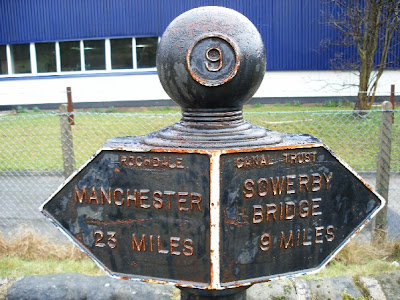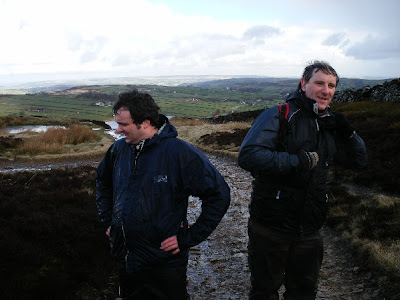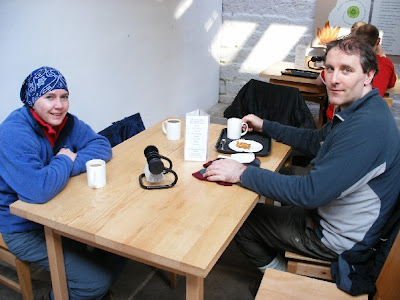 Arthur C Clarke once queried if there was such a thing as a strange coincidence (presumably just another oxymoron to him), but on 23rd June 2007 we experienced just that. The Summer-That-Never-Was promised a window of opportunity to go on a full day's walk without getting wet, so we convened in Grassington in the Yorkshire Dales to do a 10-mile walk from one of Neil's walking books to Mossdale Scar and back.
Arthur C Clarke once queried if there was such a thing as a strange coincidence (presumably just another oxymoron to him), but on 23rd June 2007 we experienced just that. The Summer-That-Never-Was promised a window of opportunity to go on a full day's walk without getting wet, so we convened in Grassington in the Yorkshire Dales to do a 10-mile walk from one of Neil's walking books to Mossdale Scar and back.The Grassington Festival was in full swing when we arrived, with a brass band in the Market Square. After vain enquiries as to whether tickets to see the lovely Hayley Westenra the following week were still available (sold out months before), and stocking up on home-made pasties and sausage rolls from the shop we set out towards the village of Conistone on the first leg of our journey.
 After an interesting journey across limestone scenery we arrived in Conistone. A pretty Dales village, we lingered awhile and broke out the sausage rolls. A collie came up to us, hoping to scavenge a little bit for himself - Ian duly obliged. Something about the name Mossdale was troubling me, I'd heard it before - but where, and in what context? The answer lay a few yards away in the churchyard, but in our ignorance we pressed on out of the village. ..
After an interesting journey across limestone scenery we arrived in Conistone. A pretty Dales village, we lingered awhile and broke out the sausage rolls. A collie came up to us, hoping to scavenge a little bit for himself - Ian duly obliged. Something about the name Mossdale was troubling me, I'd heard it before - but where, and in what context? The answer lay a few yards away in the churchyard, but in our ignorance we pressed on out of the village. ..
 A friendly dog in Conistone after our sausage rolls. Soon the postman arrived and we were forgotten.
A friendly dog in Conistone after our sausage rolls. Soon the postman arrived and we were forgotten.
 After passing through some interesting limestone gorges and a scramble up onto some high moorland we stopped for lunch. In the distance we could now see Mossdale Scar, looking somewhat less remarkable than expected. From there we were to backtrack a while before turning south towards Grassington. What was so special about this place that it would form the turning point for a walk?
After passing through some interesting limestone gorges and a scramble up onto some high moorland we stopped for lunch. In the distance we could now see Mossdale Scar, looking somewhat less remarkable than expected. From there we were to backtrack a while before turning south towards Grassington. What was so special about this place that it would form the turning point for a walk? Jo goes the hard way.
Jo goes the hard way.  Jo & Ian
Jo & IanOn we went, my GPS counting down to a spot in front of a small limestone cliff - we were here alright. Neil expressed disappointment, and dug out his walk book to read about Mossdale Scar. It turned out that on 24th June 1967 - almost exactly 40 years before to the day - 10 cavers from the University Of Leeds Speliological Association (ULSA) entered the cave system to try and explore the far passages. Apparently Mossdale Caverns is a very dangerous system, often quoted as the caving equivalent of the North Wall of the Eiger. The reason for this is that besides being very difficult technically it is extremely prone to flooding, even after small amounts of rainfall. Four of the party gave up after 3 hours and returned to the surface, walking back to Conistone where the group had left their vehicles.
David Adamson, aged 26, was among those still underground. An English teacher at Foxwood School in Leeds, he appears to have been the leader of the expedition. An experienced caver, Adamson had made several notable passage discoveries with ULSA over the previous few years . His fiancee had been one of those who had given up earlier, and four hours later as night fell she returned to Mossdale Scar to check if they had surfaced yet. There had been a a severe thunderstorm in the intervening period, and to her horror she saw the waters of Mossdale Beck gushing down the sink hole of the caverns. She ran the two and a half miles across the moor back to Conistone in darkness to raise the alarm, but it was 2am the next day before the rescue could get underway. After an enormous 18-hour rescue operation involving mechanical excavators to divert the Beck and drain the 9,000 gallon lake which had formed at the entrance, 5 of the cavers were found drowned in a 2-foot high section of the Far Marathon passage. The sixth was found later further into the system. They appeared to have been on their way back out when the flood waters hit them.
Retrieval of the bodies would have proved both difficult and dangerous, and the decision was taken to seal up with concrete the vertical entrance on the moorland above the scar that the six had used. Entry via the sink would still be possible however, and would be used by several covert explorations over the years.
In 1971, with the permission of the families of the dead (but without knowledge of the authorities), an ULSA expedition descended the caverns and moved the remains of the cavers to The Sanctuary, a higher level passage not prone to flooding and buried them there. In 1976 the sealed original entrance was opened up by a secret expedition. The landowners where Mossdale Scar stands are adamant that they will not allow any exploration, going so far as to refuse a camera crew from the BBC Yorks & Lincs regional programme Inside Out (making a feature on the 40th anniversary of the disaster) permission to film even the entrance to the caverns, saying it was too dangerous and would encourage further expeditions.

The area outside of the cavern is, of course, not dangerous and despite the impression given by the BBC documentary (reduced to filming Mossdale Scar from the air to circumvent the restriction) it is perfectly legal to walk there, being situated on Access Land (even pre-CRoW a public right of way went within yards of the sink).

The cairn marking the spot where, hundreds of feet underneath, the bodies of the six cavers were found.
(Photo by Mick Melvin)
 Next to the formerly sealed entrance the six used a plaque is attached to a stone, inscribed with the following epitaph:
Next to the formerly sealed entrance the six used a plaque is attached to a stone, inscribed with the following epitaph:"In everlasting memory from the families of
David Adamson, aged 26.
Geoffrey Warren Boireau, aged 24.
William Frakes, aged 19.
John Ogden, aged 20.
Michael John Ryan, aged 17.
Colin Richard Vickers, aged 23
Who rest here in Mossdale Caverns where they died 24th June 1967.
I will lift up mine eyes unto the hills
From whence cometh my strength."
There is also a stone memorial in the churchyard at Conistone.
Food for thought indeed for our trek back to Grassington. Back in the town the brass band had gone and there was street theatre. One of the actors gave us good reason to believe the late, great Oliver Reed might not be so late after all. How better to discuss the possibility than over a pint of Black Sheep..?
Filming where the BBC couldn't -
VIDEO - 4 min 29 sec:
Interesting Mossdale Tragedy Links
Yorkshire Post Article:
http://www.yorkshirepost.co.uk/news/Grim-anniversary-of-cavers39-descent.2978516.jp
Spirited defence of the expedition in the ULSA journal:
BBC Inside Out documentary broadcast to mark the 40th anniversary of the tragedy:


































